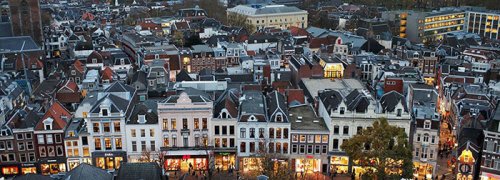How to save money and energy in buildings
7 February 2018
Incorporating energy efficiency measures in buildings can increase their value by 9-11%. Now, a new tool helps owners understand what steps to take. (This story comes from a collaboration between ING and The Guardian.)

Commercial and residential properties in Utrecht, the Netherlands. Photograph: Bloomberg via Getty Images.
Imagine you lease over 175 buildings in the Netherlands, including 18th century properties and want to improve their energy efficiency. How do you identify the upgrades that will have the most impact? And what finance is available for making the improvements?
“We knew exactly where to invest and what made the biggest differences in energy savings,” says Bas van Holten, CEO of Merin, one of the largest real-estate platforms in the Netherlands and owner of the buildings in question.
The company found 75 buildings where new heating and lighting measures could help to save more than EUR 15,000 (GBP 13,250) in energy costs per year. But how did they do it?
The answers were provided by ING’s five-step plan for navigating the transition from ‘brown’ to ‘green’ buildings, which is designed to help its commercial real estate clients meet strict minimum energy efficiency requirements for their buildings.
ING’s software allows clients to view an analysis of the energy usage of each of their buildings, what investments could be made to improve this figure, the level of C02 reduction this would achieve, and the payback period for the investment.
“If the results are above a certain threshold, ING are willing to send a team to the client for an even more in-depth analysis of the asset and how it could become a sustainable building,” says Peter Göbel, managing director of ING Real Estate Finance.
Once the benefits and costs have been fully detailed, ING offers finance for making the improvements and advises the client on other subsidies they might be eligible for, as well as how to approach the green building certification process.
For Merin, 17 ‘green experts’ were trained to oversee the upgrade process, which Van Holten estimates is now around 80% complete. He expects the upgrades will have paid for themselves within three to five years.
“The only thing we needed to do was convince our shareholders that we should invest [in the energy saving measures],” he adds, which “sounds easy, but it was still a tricky situation, as often when the owner invests in them the tenant is seen to benefit more because of their lower energy bills.”
To challenge the persistence of this perception, ING, in partnership with Maastricht University, analysed the difference in value between green and so-called brown buildings, and found that the former are a much more valuable asset.
“We came to the conclusion that over the period 2015-2016, green buildings in the Netherlands were 9-11% higher value than brown buildings,” says Göbel.
New legislation
Aside from being more valuable, green buildings are also an environmental necessity. The World Green Building Council estimates that up to 30% of greenhouse gas emissions worldwide are generated by the built environment.
The Paris climate agreement therefore included targets on green building codes and energy efficiency in buildings. And from April 2018 a new legal standard for minimum energy efficiency will apply to rented commercial buildings in the UK, which will prevent landlords from renewing existing tenancies or granting new ones if their building doesn’t meet certain energy performance criteria.
Other European countries have adopted similar measures in order to comply with the EU’s Energy Performance of Buildings Directive, with the Dutch government announcing that from 2023 buildings must have at least a C energy rating in order to be rented as office space.
“Globally we need to lose 84 gigatons of C02 from the built environment by 2050,” says Julie Hirigoyen, chief executive of the UK Green Building Council. “That basically means that all new buildings will need to be zero carbon by 2030, and all existing buildings will need to be zero carbon by 2050.”
Lenders can take the lead
Forward-thinking financial institutions are using a mix of economic incentives and stricter lending requirements to encourage commercial real estate clients to tackle this issue.
For example, as of next year ING will only offer new financing for office buildings in the Netherlands that meet the requirements for a “green” energy label. ING Real Estate Finance’s 6,000 existing clients have also been asked to come up with concrete plans to make their office buildings sustainable by 2018, earning an energy label of A, B or C.
Lenders that take the lead on finance for building improvements are likely to achieve green portfolios quicker than rival institutions (ING aims to have nothing but green buildings in its portfolio by 2023), a trend that is encouraging innovation in the financial sector. In April 2016, for instance, Lloyds launched a GBP 1 bln fund to help owners of commercial real-estate improve the energy efficiency of their buildings.
Göbel is shortly due to meet with Michael Sheren, a senior adviser to the Bank of England and co-chair of the G20 Green Finance Study Group, to discuss how ING’s app could be adapted and developed for commercial banks in the UK.
And he is optimistic that other lenders in the Netherlands will follow ING’s lead and push their clients toward making their buildings more sustainable.
“You just have to have the courage to say to them ‘this is it’, and be prepared to lose those who don’t want to go down the [sustainable buildings] route. But from talking to our clients I’m convinced that they will.”
Note: This article is paid for and produced to a brief agreed by ING, sponsor of the rethinking business hub of The Guardian.
